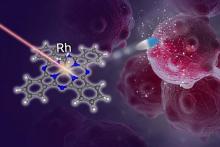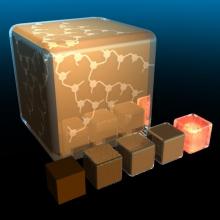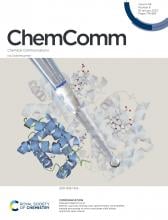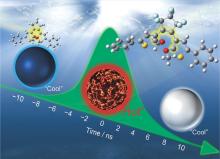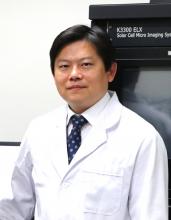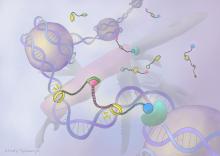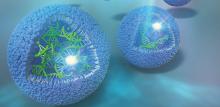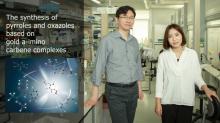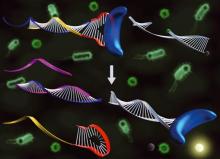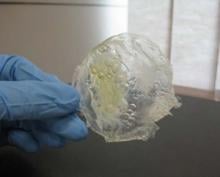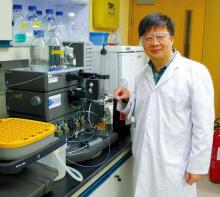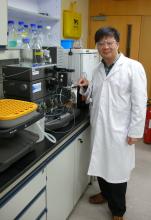Chemical Communications
News
03 Oct 2022
Osaka Metropolitan University scientists have successfully synthesized 3-hydroxybutyrate, a raw material for poly-3-hydroxybutyrate (PHB)—a strong, water-insoluble, biodegradable plastic used for packaging materials—from acetone and CO2. With a visible light-driven catalytic system utilizing sunlight and two biocatalysts, the researchers achieved a high conversion yield of about 80%. Mimicking natural photosynthesis, this study artificially reproduced a light reaction involving sunlight and a dark reaction fixing CO2 to synthesize the raw material for PHB. The finding is expected to contribute to solving the plastic waste problem and to reducing CO2.
20 Sep 2022
Researchers from The Institute of Industrial Science, The University of Tokyo have developed a streamlined photo-uncaging system for photodynamic cancer therapy, using a pulse of light for tumor-specific activation of a cancer-fighting agent
16 Sep 2022
Researchers found a new way to reduce carbon dioxide (CO2) emissions by wrapping copper nanocubes with an organic layer, solving instability and selectivity problems with copper nanocubes in catalysis, and improving how this electrocatalyst converts CO2 into organic molecules.
09 Mar 2022
- New HPHAC analogues with an embedded nonbenzenoid aromatic ring have been synthesized.
- The newly synthesized HPHACs exhibit multistep redox properties and their dicationic species showed an aromatic nature based on macrocyclic conjugation.
- Methylation on the nonbenzenoid aromatic ring resulted in the development of "antiaromaticity".
02 Mar 2022
An innovative sample preparation method for cellular proteomics and protein structural analysis
25 Sep 2020
An Ehime University group led by Dr. Ishibashi and Prof. Asahi reported that when a nanosecond laser pulse was irradiated to diarylethene nanoparticles which show the photo-induced isomerization reaction from the colored closed-form to the colorless open-form, the ring-opening reaction was at most 80 times more effective than that in the solution phase. The amplification could be well explained as a ‘photosynergetic effect’ coupled with nanoscale photothermal conversion and a photochemical reaction. There are very few reports of such a nanosecond laser pulse induced amplified photochemical reaction in nanoparticles, indicating a new photoenergy conversion method.
04 Sep 2020
Scientists at Daegu Gyeongbuk Institute of Science and Technology (DGIST) in Korea have found a way to improve the efficiency of betavoltaic devices, a type of power source that uses an internal radioactive material. This study opens up a new horizon in the field of nuclear batteries for powering set-and-forget electronic devices.
28 Feb 2020
A new compound with the potential to turn genes on and off could lead to new cancer and hereditary disease treatment strategies.
22 Jan 2020
Researchers have discovered a method to control biomolecular machines over a wide temperature range using deep-sea osmolyte trimethylamine N-oxide (TMAO). This finding could open a new dimension in the application of artificial machines fabricated from biomolecular motors and other proteins.
30 Sep 2019
DNA amplification -- a molecular "photocopying" technique where genetic material is replicated -- has many applications in scientific research, forensic science, and medical laboratories. It is useful for detecting and identifying certain forms of cancer and viral diseases, and holds promise for treating these diseases in the future.
20 Sep 2017
Discovery of small molecules that increases the number of stomata on plant leaves
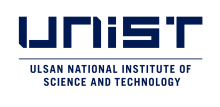
08 Dec 2016
Professor Jang Hyun Choi of Life Sciences and Professor Mi Hee Lim of Natural Science at Ulsan National Institute of Science and Technology (UNIST), South Korea, has been listed in "30 Young Scientists of Korea".
25 Aug 2016
The work by Prof. Cheol-Min Park (School of Natural Science) at Ulsan National Institute of Science and Technology (UNIST) has been selected to appear on the front cover of the prestigious journal, ChemComm.
31 Jul 2015
KAIST has developed a technique to analyze various target DNAs using an aptamer, a DNA fragment that can recognize and bind to a specific protein or enzyme.

10 Sep 2014
A separation method that isolates protein-protected gold clusters enables improved sensing of toxic mercury compounds and pesticides.

30 Jul 2014
Heat-responsive polymers that do not breakdown in water may lead to new antifouling coatings and enhanced oil recovery.

19 Jun 2013
A low-cost molecule boosts the stability and amplification characteristics of solution-based polymer semiconductors
21 Nov 2012
A novel approach produces dual-function molecules that enhance a widely used chemical reaction while reducing harmful by-products

12 Oct 2011
Multi-compartment globular structures assembled from polymer-based materials may soon serve as cell prototypes
03 Aug 2011
The concerted efforts of researchers from both PolyU and Peking University’s Shenzhen Graduate School have led to the first total synthesis of a natural marine product as a promising anti-cancer agent.
17 Nov 2010
An anti-cancer research jointly conducted by The Hong Kong Polytechnic University (PolyU) and Peking University Shenzhen Graduate School (PKUSZ) has led to the first total synthesis of an anti-cancer marine natural product, grassypeptolide.
Events
Sorry, no events coming up for this topic.
Researchers
Sorry, no researchers coming up for this topic.
Giants in history
Sorry, no researchers coming up for this topic.



